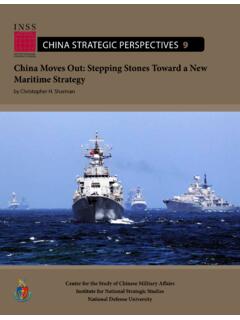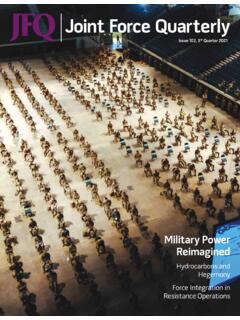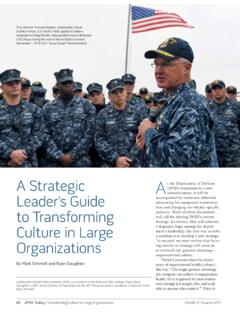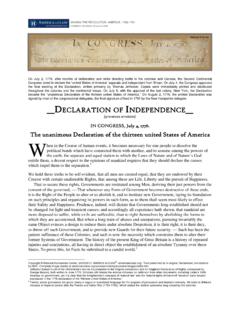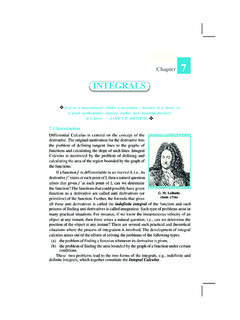Transcription of The Grand Strategy of the United States
1 The Grand Strategy of the United Statesby Hooker, Strategic MonographInstitute for national Strategic StudiesNational Defense UniversityINSS Strategic MonographNational Defense University PressWashington, 2014 The Grand Strategy of the United Hooker, , conclusions, and recommendations expressed or implied within are solely those of the contributors and do not necessarily represent the views of the Defense Department or any other agency of the Federal Government. Cleared for public release; distribution of this work may be quoted or reprinted without permission, provided that a standard source credit line is included.
2 NDU Press would appreciate a courtesy copy of reprints or : President Barack Obama and Vice President Joe Biden meet with members of the national Security Council in the Situation Room of the White House hours before his national address, September 10, 2014 (The White House/Pete Souza)First printing, October 2014 ContentsThe Roots of American Grand Strategy ..1A Century Like No Other ..4 The Ends of Grand Strategy ..14 The Means of Grand Strategy .. 19 The Ways of Grand Strategy ..21 The Way Ahead ..24 Notes ..27 About the Author.. 35 1 The Grand Strategy of the United StatesFrom the earliest days of the Republic, the outlines of an evolving American Grand Strategy have been evident in our foreign and domestic Much of that history continues to inform our strategic conduct, and therefore American Grand Strategy rests today on traditional foundations.
3 Despite a welter of theory and de-bate, Grand Strategy as a practical matter is remarkably consistent from decade to decade, with its means altering as technology advances and institutions evolve but its ends and ways showing marked continuity. Grand Strategy can be understood simply as the use of power to secure the Thus, it exists at a level above particular strategies intended to secure particular ends and above the use of military power alone to achieve political objectives. One way to comprehend Grand Strategy is to look for long-term state behavior as defined by enduring, core security interests and how the state secures and advances them over time.
4 In a way, this means that what the state does matters more than what the state says. Grand Strategy is therefore related to, but not synonymous with, national Se-curity Strategies, national Military Strategies, Quadrennial Defense Reviews, or De-fense Strategic Guidance. Grand Strategy transcends the security pronouncements of political parties or individual administrations. Viewed in this light, American Grand Strategy shows great persistence over time, orienting on those things deemed most important those interests for which virtually any administration will spend, legislate, threaten, or fight to defend.
5 The Roots of American Grand StrategyAmerican Grand Strategy cannot be understood without a historical grounding. Prior to the Revolution, the defense of the colonies as a whole was left to the British crown, and the colonial militia handled local defense. Contention between the great powers (Spain, the Netherlands, France, and Great Britain) on the North American continent bred an enduring distaste among the colonists for international interven-tion in the Western hemisphere. Prerevolutionary warfare was endemic and nearly constant in North America, fostering on the one hand a familiarity with conflict, but on the other a distrust of standing forces that would condition American strategic thought for several 2 INSS Strategic MonographAs the United States became more firmly established, this impulse found ex-pression in the Monroe Doctrine and in a general aversion to involvement in Euro-pean wars that dated from President George Washington s first This aversion stemmed in part from military and economic weakness.
6 But the desire not to become enmeshed in the politics of a great power rivalry also played a key role. America was fortunate not to be drawn more deeply than it was into the French revolutionary and Napoleonic wars, and thereafter the desire to pursue continental expansion and to exclude further European colonization of the hemisphere shaped our policy and Strategy for the rest of the 19th From the start, American Grand Strategy also carried a defining ideological com-ponent. While generally pragmatic, early American political and military leaders were strongly influenced by the ideals of the Enlightenment and the Revolution and by an emerging American political Since the Revolutionary era, most American conflicts have been articulated and justified with some reference to this founding ideology, lending a distinctive, normative dimension to American Strategy and strategic culture.
7 Sometimes described as American exceptionalism, this com-ponent has been seen by some as an impulse to promote democratic values and the rule of law abroad as well as at home, and by others as an excuse for our historical narrative emphasizes reliance on local militia forces, regular forces or volunteer units raised outside the militia organizational structure have formed the center of gravity of America s military establishment as far back as the Revolutionary For all significant campaigns at least through the Korean conflict, the pattern or cycle of America at war featured small regular forces, an ex-pansion of the Army during the conflict through a combination of militia call-ups, volunteering, and conscription, and then a drawdown or return to prewar levels.
8 This original aversion to large standing forces was undoubtedly rooted in the English Civil War; many of the original colonists came to the New World to escape the repres-sion and incessant conflict of the Old World, and those memories became firmly imprinted in their cultural DNA. Throughout the 19th century, the United States grew and evolved as a rising re-gional power, only achieving great power status at the beginning of the 20th collapse of the Spanish empire in South America and the 1867 emergence of 3 The Grand Strategy of the United StatesCanada as an independent commonwealth nation accelerated an effective end to European presence in the Western Hemisphere that was rendered final with the ejec-tion of Spain from Cuba and Puerto Rico in Territorial expansion through the Louisiana Purchase, Mexican-American War, Alaska Purchase.
9 And Indian Wars com-pleted the process of continental growth, accompanied by large-scale immigration from Europe, the transcontinental railroad, a growing and powerful mercantile ca-pacity, and industrialization on a broad scale thus setting conditions for America s evolution into a superpower in the following century. Overshadowing everything else in the 19th century is the American Civil War. Vast in scope and scale, the Civil War fundamentally challenged the survival of the Nation and its constitutional system. More Americans died in the Civil War than in all other wars. Over the course of the conflict, large land and naval forces were raised, conscription was invoked, and modern technologies like mass production, military railroads, the telegraph, breech-loading, rifled artillery, repeating rifles, and iron-clad warships were introduced.
10 Modern military professionalism and general-ship replaced the notion of the talented amateur. Profound political questions were settled, most importantly the central role and importance of the Federal Govern-ment and the President as chief executive and commander in chief. There would be no going back. Though the military establishment returned to prewar levels following the Civil War, the precedent of mass mobilization under an organized War and Navy Depart-ment and professional generals and admirals had been well established. Professional military education took root, notably at the Naval War College at Newport, Rhode Island, and at the Army s School of Application for Infantry and Cavalry (later the Command and General Staff College) at Fort Leavenworth, Up through the Spanish-American War, the Army performed essentially constabulary duties, while the Navy steadily evolved toward a modern, capable, technically proficient arm of the service with a coherent doctrine.


